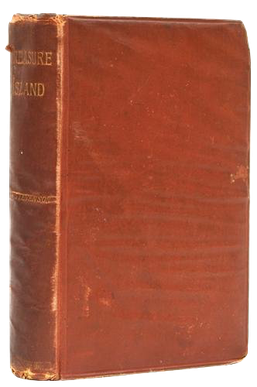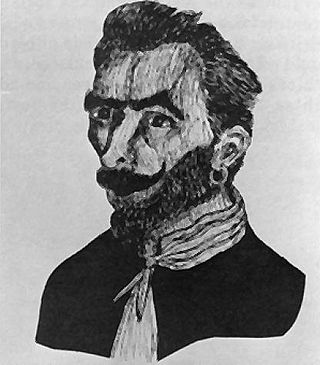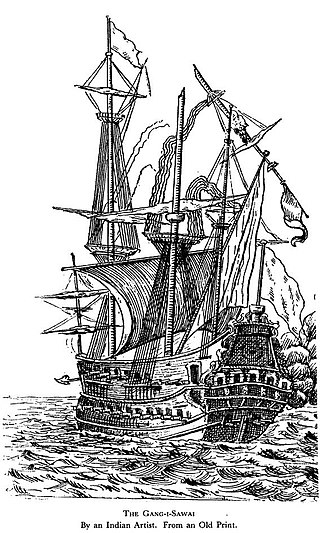Related Research Articles

Treasure is a concentration of wealth — often originating from ancient history — that is considered lost and/or forgotten until rediscovered. Some jurisdictions legally define what constitutes treasure, such as in the British Treasure Act 1996.

Treasure Island is an adventure novel by Scottish author Robert Louis Stevenson, telling a story of "buccaneers and buried gold". It is considered a coming-of-age story and is noted for its atmosphere, characters, and action.
Captain Jack Sparrow is a fictional character and the main protagonist of the Pirates of the Caribbean film series and franchise. An early iteration of Sparrow was created by screenwriters Ted Elliott and Terry Rossio, but the final version of the character was created by actor Johnny Depp, who also portrayed him.
Captain Samuel Bellamy, later known as "Black Sam" Bellamy, was an English sailor turned pirate during the early 18th century. He is best known as the wealthiest pirate in recorded history, and one of the faces of the Golden Age of Piracy. Though his known career as a pirate captain lasted little more than a year, he and his crew captured at least 53 ships.

Buried treasure is a literary trope commonly associated with depictions of pirates, alongside Vikings, criminals, and Old West outlaws. According to popular conception, these people often buried their stolen fortunes in remote places, intending to return to them later.

Norman Island is an island at the southern tip of the British Virgin Islands archipelago. It is one of a number of islands reputed to be the inspiration for Robert Louis Stevenson's pirate novel Treasure Island.

José Gaspar, also known by his nickname Gasparilla, is a fictional Spanish pirate who terrorized the Gulf of Mexico from his base in southwest Florida during Florida's second Spanish period. Though details about his early life, motivations, and piratical exploits differ in various tellings, they agree that the 'Last of the Buccaneers" was a remarkably active pirate who amassed a huge fortune by taking many prizes and ransoming many hostages during his long career and that he died by leaping from his ship rather than face capture by the U.S. Navy, leaving behind his still-hidden treasure.

The Golden Age of Piracy is a common designation for the period between the 1650s and the 1730s, when maritime piracy was a significant factor in the histories of the North Atlantic and Indian Oceans.

Treasure hunting is the physical search for treasure. For example, treasure hunters try to find sunken shipwrecks and retrieve artifacts with market value. This industry is generally fueled by the market for antiquities. The practice of treasure-hunting can be controversial, as locations such as sunken wrecks or cultural sites may be protected by national or international law concerned with property ownership, marine salvage, sovereign or state vessels, commercial diving regulations, protection of cultural heritage and trade controls.

Treasure Island is a 1934 film directed by Victor Fleming and starring Wallace Beery, Jackie Cooper, Lionel Barrymore, Lewis Stone, and Nigel Bruce. It is an adaptation of Robert Louis Stevenson's famous 1883 novel of the same name. Jim Hawkins discovers a treasure map and travels on a sailing ship to a remote island, but pirates led by Long John Silver threaten to take away the honest seafarers’ riches and lives.

A treasure map is a map that marks the location of buried treasure, a lost mine, a valuable secret or a hidden locale. More common in fiction than in reality, "pirate treasure maps" are often depicted in works of fiction as hand drawn and containing arcane clues for the characters to follow. Regardless of the term's literary use, anything that meets the broad definition of a "map" that describes the location of a "treasure" could appropriately be called a "treasure map."
Urca de Lima is a Spanish shipwreck near Fort Pierce, Florida, United States. She was part of the 1715 Treasure Fleet, one of the numerous Spanish treasure fleets sailing between Spain and its colonies in the Americas. The wreck is located north of Fort Pierce Inlet, 200 yards off the shore from Jack Island Park. It became the first Florida Underwater Archaeological Preserve when dedicated in 1987. This was followed on May 31, 2001 with its addition to the U.S. National Register of Historic Places.

In English-speaking popular culture, the modern pirate stereotype owes its attributes mostly to the imagined tradition of the 18th-century Caribbean pirate sailing off the Spanish Main and to such celebrated 20th-century depictions as Captain Hook and his crew in the theatrical and film versions of J. M. Barrie's children's book Peter Pan, Robert Newton's portrayal of Long John Silver in the 1950 film adaptation of the Robert Louis Stevenson novel Treasure Island, and various adaptations of the Middle Eastern pirate, Sinbad the Sailor. In these and countless other books, films, and legends, pirates are portrayed as "swashbucklers" and "plunderers". They are shown on ships, often wearing eyepatches or peg legs, having a parrot perched on their shoulder, speaking in a West Country accent, and saying phrases like "Arr, matey" and "Avast, me hearty". Pirates have retained their image through pirate-themed tourist attractions, film, toys, books and plays.

Piracy in the British Virgin Islands was prevalent during the so-called "Golden Age of Piracy", mainly during the years of 1690-1730. Privateering was also widely practised in the jurisdiction throughout frequent colonial wars, not least by emancipated slaves who, with in preference to back-breaking labour in the fields for pitiful wages, took enormous risks to capture fortunes on the seas with the sanction of the Crown. In 1808, Patrick Colquhoun, a prize agent for the Territory spoke of "the most daring outrages which are frequently committed by people of colour."

Billy Bones is a fictional character appearing in the first section of Robert Louis Stevenson's 1883 novel Treasure Island.

The Ganj-i-Sawai was an armed Ghanjah dhow belonging to the Mughals. During Aurangzeb's reign, it was captured on 7 September 1695 by the English pirate Henry Every en route from present-day Mocha, Yemen to Surat, India. It was built on the order of Empress Mariam-uz-Zamani, great grandmother of Aurengzeb, after the capture of her ship named Rahimi.

Treasure Island is a 1920 silent film adaptation of the 1883 novel by Robert Louis Stevenson, directed by Maurice Tourneur, and released by Paramount Pictures. Lon Chaney played two different pirate roles in this production, "Blind Pew" and "Merry", and stills exist showing him in both makeups. Charles Ogle, who had played Frankenstein's Monster in the first filmed version of Frankenstein a decade earlier at Edison Studios, portrayed Long John Silver. Wallace Beery was supposed to play Israel Hands, but that role went to Joseph Singleton instead. The film was chosen as one of the Top Forty Pictures of the Year by the National Board of Review.

Jim Hawkins is a fictional character and the protagonist in Robert Louis Stevenson's 1883 novel Treasure Island. He is both the protagonist and main narrator of the story.
Jean Hamlin was a French pirate active in the Caribbean and off the coast of Africa. He was often associated with St. Thomas's pirate-friendly Governor Adolph Esmit.
References
- 1 2 3 "Hobby Paying Markets. Lost Treasure Magazine". Writers Weekly. Retrieved 29 November 2015.
- ↑ "Lost Treasure magazine". Freelance Writing. Archived from the original on December 8, 2015. Retrieved October 25, 2015.
- 1 2 Stephen Blake Mettee; Michelle Doland; Doris Hall (1 December 2006). American Directory of Writer's Guidelines: More Than 1,700 Magazine Editors and Book Publishers Explain What They Are Looking for from Freelancers. Quill Driver Books. p. 378. ISBN 978-1-884956-58-4.
- ↑ Steve Herschbach (December 23, 2018). "Lost Treasure Magazine Ceases Publication After 52 Years". Detector Prospector. Retrieved October 9, 2020.
